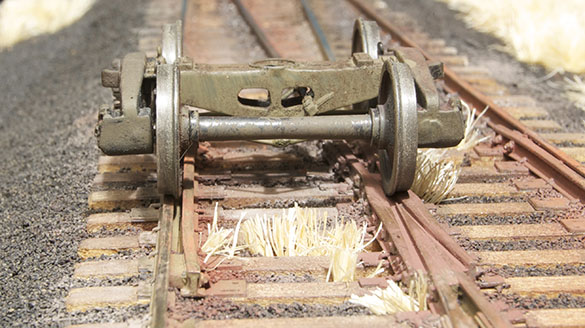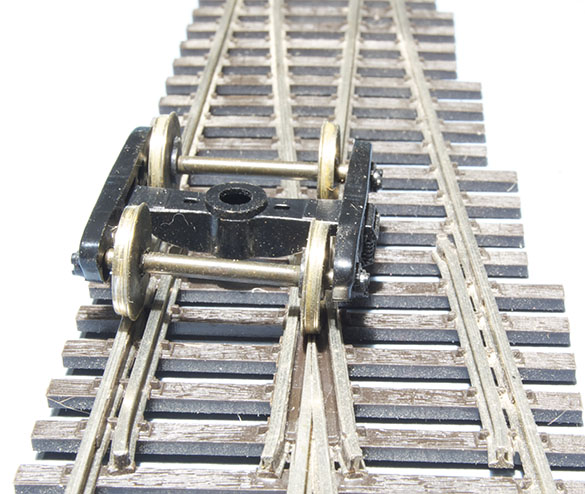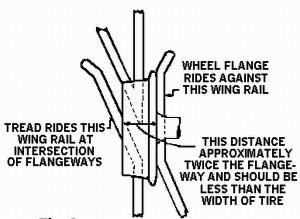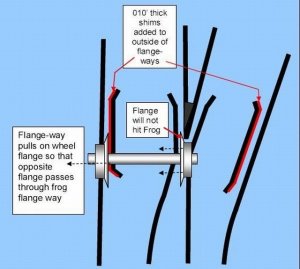While researching this subject recently, of 'excessive size flangeways' in commercially available turnouts, I was finding lots of really interesting discussions scattered about the internet and multiple railroad forums. I was running out of bookmarks to try and recall all of them. That prompted me to start this subject thread to try and bring a lot of those discussions, links and photo references into one central subject thread that I could revert back to when I failed to remember some particular posting on specific 'derailment problems' of our turnouts.
Naturally it is not just problems with the turnouts nor the wheels themselves individually. Its a 'system' of the two.
So I thought this posting was rather interesting to start the subject thread out,...
[url]http://www.ostpubs.com/systems-thinking/[/URL]
That's some interesting history I was unaware of, or had forgotten
Naturally it is not just problems with the turnouts nor the wheels themselves individually. Its a 'system' of the two.
So I thought this posting was rather interesting to start the subject thread out,...
[url]http://www.ostpubs.com/systems-thinking/[/URL]
The following is an excerpt from The Missing Conversation Vol. 03, coming Jan. 1, 2013.
As John Armstrong notes in his classic book: The Railroad-What It Is, What It Does, it is futile to argue which was more important, a track system of rails, flanged wheels or the concept of coupling multiple cars together to form a train. All three taken together make up the most significant system of technology in the history of transportation to date: applying the heat energy output of a machine to transcend the capacity of animal power in moving cargo.
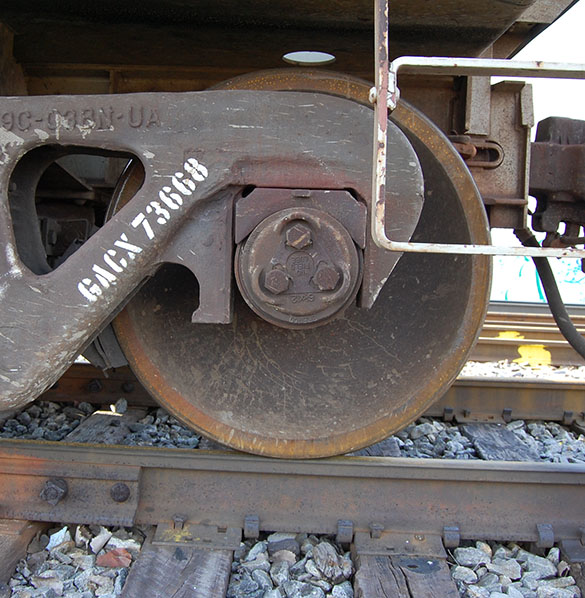
Wheels
A prototype wheel looks deceptively simple at first glance, yet it is anything but. Full size train wheels have a number of functions to perform, with millions of dollars of freight and many lives riding on the outcome. Railroad wheels and track are a complex, integrated system that is carefully monitored and maintained for the safety of all concerned. As we’ll see, standards are critically important.
The beginning
The earliest railroad wheels were little more than modified wagon wheels that were sufficient to carry the lightweight railroad cars of the day. Although spoked wheel designs in both wood and metal were quite common, they soon proved unsuitable and were replaced by wheels having a disk design, typically of cast iron, which was easily worked by the metal smiths of the era. These designs evolved into the wheels we know today.
Cast iron tends toward brittleness and foundry men discovered that an extremely hard chill developed in the iron if it was poured next to another iron surface. This chilled area, as deep as an inch, could not be machined and was typically avoided. However, it proved ideal for the wear surface on freight car wheels. Therefore the rim and flange were poured as a unit against an iron ring, leaving the interior and hub areas soft and machinable.
Other considerations
You would think things like wheel diameter, tire width and flange depth appear straightforward enough, yet such was not the case initially.
Take the diameter for example. Larger wheels provided a better ride but added to the dead weight of the car. They were more expensive too, an important consideration given the ultimate number of wheels required by any line.
From what is known, a diameter of 36 inches appears to have been an early standard for freight cars. However, roads like the B&O used smaller 30 inch wheels on certain cars in the 1830s progressing in size to 31 inches, even though a compromise of diameter of 33 inches was widely accepted in America by the 1840s.
Gauging the impact of interchange
Early railroads were essentially closed systems. The trains of one line typically didn’t travel on competing lines and passengers and freight were manually transferred at end points or junctions. As rail travel and shipping of freight became more widespread, this cumbersome process began to fall apart. With manual transloading being horribly inefficient, the superiority of having cars able to travel freely from point to point soon became clear. Yet there was a huge problem looming: track gauge was anything but universal.
The interchange of freight cars among competing rail lines was unprecedented in American business history. It worked because everybody benefitted, either by increased efficiency, lower costs or both. The fly in the ointment was the wide variety of track gauges used in the United States at this time. Driven by local political interests, hubris among the “empire builders”, greediness in keeping traffic confined to their system or just an urge to be different, track gauge standards were all over the place. Pioneered by brothers George and Robert Stephenson, the Stephenson gauge of 4’ 8.5” was commonly used, accounting for over 50 percent of track miles in 1861, with the 4’10” gauge common in the states of Ohio and New Jersey only accounting for 9.9 percent. In the American South, five feet was the common standard comprising 21.9 percent of total miles of track, while the Erie Railroad’s famously broad gauge of six feet only represented a mere 5.3 percent.
Think that’s wide? A line in Missouri used 6’ 6” as their gauge for reasons no one understood. Rail lines in between these extremes used a gauge of 4’9” in an attempt to compromise the differences between the Stephenson gauge and 4’ 10”. Given the extent of trackage laid, compromise solutions to the problems of interchange abounded. Some were more laughable than others.
One stop-gap idea widely adopted for a time was an extra wide wheel tread that could traverse tracks laid to 4’-8.5” up to 4’10”. This proved to be ill-conceived at best because the running qualities of these wheels were horrible, due to the fact they didn’t conform to either gauge. By necessity the wheel flanges had to be gauged to the narrowest track leaving a lot of side-to-side slop on the wider gauges. Cars so equipped could only be moved at slow speeds and, while freight might withstand some jostling around, passengers were less tolerant. Suffice to say that railroad men hated these things.
Other schemes such as exchanging trucks, multi-gauged track composed of three and, in one case, four rails were all tried but the only solution that was going to work efficiently was to adopt a standard track gauge dimension. With miles of track already laid many lines were resistant to regauging their track, yet the handwriting was on the wall and all lines eventually adopted the Standard Gauge of 4’ 8.5”. Finally, a car could travel from one part of the country to another without the problems of delay from transloading, switching trucks and other impediments.
That's some interesting history I was unaware of, or had forgotten
Last edited by a moderator:

